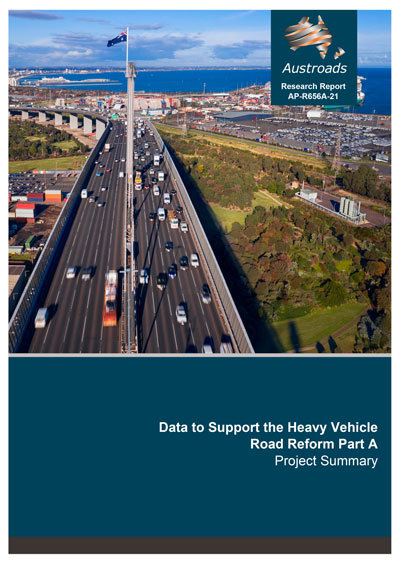Monday, 6 September 2021

Austroads has published a series of reports detailing the findings of a project which has investigated different aspects of the requirements, gaps, and opportunities for supplying infrastructure data suitable for supporting a future heavy vehicle cost recovery and investment process.
The project represents a total of seven years of work from 2013 to 2020.
Ross Guppy, Austroads Road Infrastructure Program Manager, says increasing the amount and improving the quality of nationally consistent information about the nature and condition of Australia’s roads, is a critical component of building a more efficient, fairer system for making decisions about road spending.
“The Heavy Vehicle Road Reform is a joint reform process of the Commonwealth, state, territory, and local governments. It is aiming to establish an economic market for the provision and use of heavy vehicle infrastructure services. One that provides clear links between the needs of users, the charges they pay and the services they receive.”
“Properly functioning markets require informed users and road providers. In the case of road provision and funding, improvements to data availability, accuracy, and timeliness will allow for more rigorous reporting of road service delivery against agreed standards, providing greater transparency and accountability to customers,” Ross said.
The Asset Register, Heavy Vehicle Infrastructure Ratings, and investigations of data availability, quality, and structure that were the focus of this project are all part of a package of measures that aim to establish an openly available baseline of information required to transition to the provision of heavy vehicle infrastructure as an economic service over the longer term.
The eight parts of the report can be downloaded in one PDF or as individual documents as follows:
Part A: Project Summary provides an overview of the Heavy Vehicle Road Reform, the role of the project in the Reform, a summary of each Part (B to H) of the project, and the overall conclusions drawn from the project.
Part B: Heavy Vehicle Infrastructure Rating describes the development of the Heavy Vehicle Infrastructure Rating (HVIR) Framework as a potential measure of how fit-for-service a road is for heavy vehicles. This Part also describes the development, features and processes of the HVIR Tool intended to allow road managers to assemble data and generate HVIR results in a consistent way.
Part C: National Road Asset Register describes the development of standards, tools, and processes for building a nationally consistent database at 100 m intervals containing infrastructure-related information including reference, inventory, operational and condition data. In addition, an investigation was conducted into the requirements for an open data environment through development of open-source code for populating the National Road Asset Register and revising the data specification for the Asset Register to expand its application beyond Australian road agencies.
Part D: Infrastructure Base Map and Data Alignment Guidance presents a discussion of the merits of various mapping platforms, and guidance on how various data elements can be aligned to the base map in a nationally consistent way.
Part E: Traffic Data Analysis reports on an investigation of traffic data, documenting how traffic data is collected, processed, and presented to illuminate the causes of inconsistencies between this data from Australian road agencies.
Part F: Alignment of Expenditure Reporting Data provides the results of a study of the extent and causes of inconsistencies in forecast and actual expenditure data submitted by Australian road agencies to the National Transport Commission (NTC) for the Forward-Looking Cost Base (FLCB) model.
Part G: Stocktake of Pavement Deterioration Modelling is based on a survey of pavement deterioration modelling teams within Australian road agencies to list the models, data, and processes used in the modelling of pavements.
Part H: Investigation of Maintenance Data Records reports on a survey of the nature and extent of record-keeping related to routine and periodic maintenance within Australian road agencies.
Join us on Tuesday, 28 September 2021 for an online summary of the project’s main activities and key learnings with one of the authors Ulysses Ai. No charge, but registration essential. Can’t make the live session? Register and we’ll send you a link to the recording.
